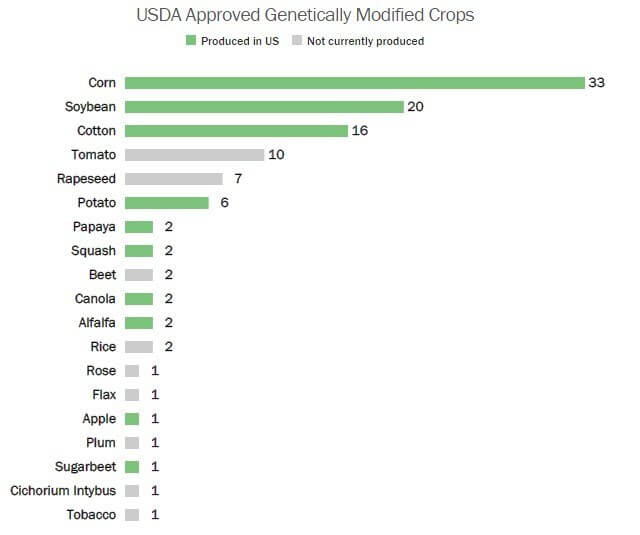Chipotle announced Monday that the chain will no longer serve food containing genetically modified organisms (GMO), raising the bar for transparency in the United States, where there's no requirement to indicate the presence of GMO ingredients on food labels or in restaurants. Likewise, biotechnology companies aren't required to report which genetically modified seeds are used in production.
Yet the use of GMOs is undoubtedly widespread. Since GMOs were approved for commercial use, and then first planted into U.S. soil in 1996, their production has increased dramatically. More than 90% of all soybean cotton and corn acreage in the U.S. is used to grow genetically engineered crops. Other popular and approved food crops include sugar beets, alfalfa, canola, papaya and summer squash. More recently, apples that don't brown and bruise-free potatoes were also approved by the FDA.
Adoption of GMO Crops in the US, 1996-2014
It's also instructive to look at permits granted by the United States Department of Agriculture (USDA) and the Food and Drug Administration (FDA) — the American GMO gatekeepers, together with the Environmental Protection Agency – though it's important to note that not all the issued permits are for crops that are approved for commercial use.
To produce crops commercially, biotech companies apply for "deregulated status", the green light from the USDA to plant and distribute without restriction.
The bar chart below shows all deregulated crops, sized by the number of genetic varieties approved for each. The ten crops in green are currently produced in the United States, and described in detail in the list below.

3. Cotton
Much of GM cotton is turned into cottonseed oil, which is used for frying in restaurants and in packaged foods like potato chips, oily spreads like margarine, even things like cans of smoked oysters. Some parts of the plant are also used in animal feed, and what's left over can be used to create food fillers such as cellulose.

5. Papaya
Bred to withstand ringspot virus, which can destroy papaya plants, these genetically engineered 'Rainbow Papayas' were first commercially produced in the late 1990s. Much of the yield is grown in Hawaii.
2 Genetically Modified Varieties

6. Squash
Zucchini and yellow summer squash have been commercially available in the U.S. since the mid- to late-'90s, though GM squash accounts for just 25,000 acres of farmland, by some estimates.
2 Genetically Modified Varieties

7. Canola
GM canola is used to make oil for cooking, as well as margarine. It's also used to produce emulsifiers that are used in packaged foods. By some estimates, 90% of canola grown in the U.S. and Canada is GM.
2 Genetically Modified Varieties

8. Alfalfa
In a controversial decision in 2011, the FDA approved the commercial use of GM alfalfa that contains a gene making it resistant to herbicide. The crop is used mainly as hay for cattle.
2 Genetically Modified Varieties

9. Apples
Another newly approved crop, this apple from a Canadian biotech company does not brown even after it's been sliced. It recently received FDA approval. The agency said it is safe to eat, which means they may appear on supermarket shelves.
1 Genetically Modified Variety

10. Sugar Beets
More than half the granulated sugar in the United States comes from GM sugar beets, which have been in production since 2008. Though their use was temporarily halted due to safety concerns, production resumed in 2011.
1 Genetically Modified Variety
Methodology
GM crops produced in the U.S. are listed at the International Service for the Acquisition of Agri-biotech. Deregulated crops are tracked at the USDA's Animal and Plant Health Inspection Service.









Canola黄花就是油菜花吧?问候股兄,周末愉快!
去加拿大,大片的Canola黄花,十分状观!